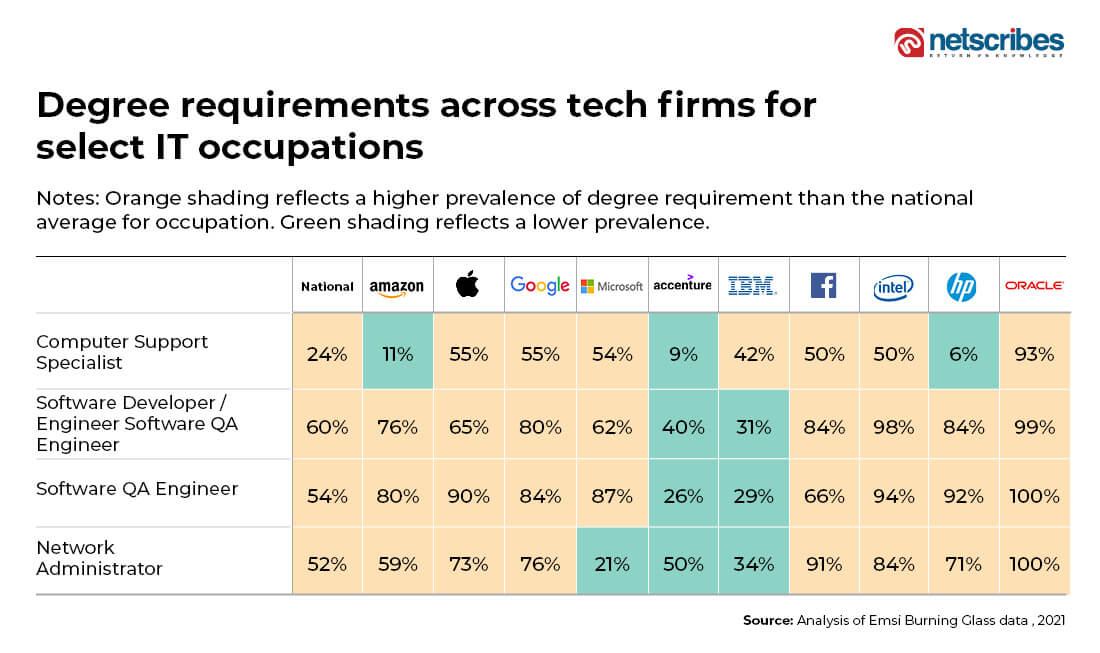IT professionals are increasingly in demand as organizations put digital transformation at the center of their growth strategies. The US Bureau of Labor Statistics reported that employers across industries hired 180,000 technologists in December. Meanwhile, tech unemployment reached 2% – less than half of the national unemployment rate, which stood at nearly 4%.
Although the demand for skilled tech professionals has grown, the number of employable individuals with those skills has not increased at the same rate. According to KPMG, chief information officers report that skills shortages are hindering their organization’s ability to keep up with the pace of change. A skill shortage is exacerbated by the “Great Resignation” problem, in which a large number of people have quit their jobs. Employers are then left scrambling to replace those positions as people with employable skills have their pick of roles.
Nevertheless, every problem presents an opportunity for innovation – and the tech industry symbolizes this very fact. Let’s explore how companies are rising to the skills and talent shortage challenge with innovative solutions.
1. Partnerships with universities and edtech companies
According to a recent Bloomberg study, a mere 35 percent of employers say that they are confident that their new recruits will possess hard technical skills as well as “soft skills” such as analytical and problem-solving skills. Therefore, corporations are partnering with educational institutions with a focus on developing requisite skills.
Google, for example, is offering many online certificates in the field of Internet Technology in partnership with both small community colleges and even larger universities like Northeastern. Recently, the company announced a partnership with 25 community colleges that will enable students to earn an IT Support Professional certificate. Students can enroll in courses ranging from applied digital skills to IT security thanks to Coursera’s partnership with the tech giant. Upon completing the course, graduates can directly share their certificate with one of the many corporate partners involved, such as GE Digital.
2. Skills-based hiring
The tightening of the labor market has led more organizations to prioritize skills over degrees to broaden the talent pools available to them. This shift toward relaxing degree requirements is visible across renowned companies, including Apple, LinkedIn, IBM, and Amazon.
IBM issued the following statement in January 2021: “IBM has now stripped bachelor’s degree requirements for more than half of our US job openings, and we’re continuously reevaluating our roles to prioritize skills over specific degrees”.

When it comes to stripping the requirements for degrees from job postings, IBM is ahead of the competition. Only 29% of its job postings require a degree for IT positions.
3. Flexible working models
According to a report by Robert Half, 69% of tech-hiring managers reported that retaining valued employees had become harder post the pandemic. There exists a significant percentage of the workforce who are disengaged and unmotivated to work in remote work setups.
According to Personio’s survey, which asked 1,205 senior HR decision-makers and 5,000 employees across several countries in Europe and the UK, workers who have primarily worked remotely over the past 12 months are more likely to be looking for new jobs. As a result, more employers are shifting towards hybrid arrangements as they struggle with hiring and retention issues, particularly within tech teams.
Sundar Pichai, CEO of Google and Alphabet wrote in a recent blog post. “We’ll move to a hybrid work week where most Googlers spend approximately three days in the office and two days wherever they work best. Since in-office time will be focused on collaboration, the product areas, and functions will help decide which days teams will come together in the office. There will also be roles that may need to be on-site more than three days a week due to the nature of the work,”
4. Internal talent marketplaces
One of the most transformative solutions emerging amid the Great Resignation is internal talent marketplaces. As the name suggests, it’s a digital platform that provides visibility into employee skills and capabilities available across the organization.
In the past, the skills of employees were only accessible within their teams. Internal marketplaces eliminate these barriers, enabling employees’ expertise to be applied across departments. This results in better resource utilization as employees lend a hand when they have extra capacity and help organizations achieve performance goals collaboratively.
Savvier enterprises are building AI-enabled talent marketplaces. Based on employees’ work experience, these platforms can infer the skills an employee has and then matches them to relevant jobs. It takes the guesswork out, which is critical to making sure leaders are creating opportunities equally.
Infosys launched F.L.U.I.D., an AI-driven talent marketplace that enables Infoscions to continuously acquire higher-order skills and experiences. Additionally, its Internal Job Posting initiative enables talent rotation at Infosys. Through this initiative, employees can explore opportunities across lines of business and move up the ladder to senior positions. Of all job openings in FY21, 20% were filled through Internal Job Postings. The majority (80%) of the company’s digital project requirements were staffed internally within a year of upskilling.
Similarly, TCS’ Talent Cloud – an algorithmic-based marketplace and an internal gig workers’ community pairs talent anywhere, anytime with business requirements.
5. Tech-driven hiring
From identifying upskilling and staffing needs to onboarding a new hire, technology can be used throughout the recruitment process and is playing a crucial role in helping organizations find the right talent to meet their growth objectives.
Accenture CEO, Julie Sweet, said “We used AI algorithms to identify who could be reskilled, what family of skills are close to what we have more demand on, and then we can actually do the reskilling. In the first six months after the pandemic, the company upskilled about 100,000 people with programs that ranged from eight to 15 weeks, depending on what we were upskilling them for.”
According to IBM, its AI system can predict when an employee will quit their job with up to 95% accuracy. By implementing the AI program, IBM was able to save about $300 million in employee retention costs. Through its AI-powered virtual assistant, MYCA (My Career Advisor), the company helps employees identify where their skills need to be improved. In addition, the technology’s companion, Blue Match, provides employees with job openings based on their skills. Blue Match is said to have assisted 27 percent of IBM workers who received a job or promotion in 2018.
With talent shortages gripping industries globally, enterprises are leveraging these tactics to drive agility and digital transformation in their organizations. Netscribes provides timely data and insights to help organizations identify and act on such challenges quickly and decisively. Contact us to know more about how our research services can help.






